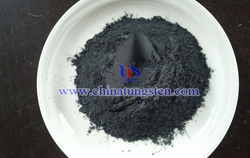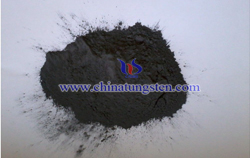Tungsten Powder and Bronze Composite Material
- Details
- Category: Tungsten Information
- Published on Wednesday, 06 July 2016 17:58
Lead has been used in a variety of industrial applications for many thousands of years. In the last hundred years, the toxic effects of lead have become apparent. In an effort to reduce reliance on lead, there has recently been extensive research into materials that could be used to replace lead.
In this regard, much effort has been focussed on producing metal composites that mimic the properties of lead. Since the density of lead is the most obvious characteristic to mimic, most efforts have concentrated on finding composites that have the same or similar density as lead. However, other important properties of lead have been largely ignored and, as a result, no completely satisfactory lead replacement has yet been found.
In addition to being non-toxic and to having a similar density to lead, a successful composite should have reasonable softness coupled with structural rigidity. Ideally the composite is substantially homogeneous and relatively cheap to manufacture in large quantities.


There still remains a need for a composite materials having a suitably high density, suitable processing characteristics and suitable properties for a variety of applications.
There is provided a composite comprising tungsten and bronze.
There is also provided a composite consisting essentially of tungsten, bronze, and iron.
There is also provided a process for producing a composite, the process comprising: blending powdered tungsten, powdered bronze, and an organic binder, thereby forming a homogeneous mixture; compounding the mixture at elevated temperature; and, cooling the mixture to form a composite having consistent characteristics throughout the composite.
There is also provided a process for producing an article comprising: providing a mold having an open ended cavity; placing a quantity of a homogeneous mixture of powders comprising tungsten and bronze in the cavity; placing a quantity of a powdered infiltrant on the mixture of powders in the cavity; sintering the mixture of tungsten and bronze powders at a first temperature followed by melting the infiltrant at a second temperature; and, cooling the mold and the articles formed therein.
Tungsten is generally used in the form of tungsten powder of polygonal shape and may be milled to the desired shape and mean particle size. The mean particle size is preferably about 0.5–50 μm, more preferably about 1–20 μm.
Bronze is typically an alloy of copper and tin. The ratio of copper to tin may vary depending on the particular alloy and the desired proportions of copper to tin in the composite. Most industrially useful compositions have a tin content of under 25% by weight. Many other additions at various levels are commonly used to alter the properties of bronzes. These may include but are not limited to metals and non-metals such as zinc, iron, manganese, magnesium, aluminium, phosphorus, silicon, lithium compounds, etc. Preferably, bronze having a Cu:Sn ratio of about 9:1 is used, this includes bronze having a Cu:Sn ratio of 89:11. Bronze is preferably used in the form of a powder and may be milled to the desired shape and mean particle size. The mean particle size is preferably under 100 μm, more preferably under 50 μm.
Generally, the density of the composite can be adjusted at will by varying the ratio of tungsten (density=19.3 g/cc) and bronze (density=8.9 g/cc for a 90:10 alloy of Cu:Sn).
It was found that a composite comprising 40–85% tungsten by weight of the composite, the balance being bronze comprising 80–95% copper and 5–20% tin by weight of the bronze, was effective at producing a composite suitable for use as a lead replacement. Preferably, the composite comprises 50 to 55% tungsten, even more preferably 52% tungsten by weight of the composite and the bronze comprises copper and tin in a ratio of about 9:1 by weight of the bronze.
Tungsten particles offer resistance to densification during compaction as well as sintering. These issues may place an upper limit on the useful fraction of tungsten. The latter issue can also be partially offset by using finer tungsten grains.
The use of bronze in the formation of tungsten composites offers significant advantages over composite materials that have previously been described in the art, including the three component systems described in U.S. Pat. No. 5,950,064. Surprisingly, it has been found that suspensions of tungsten in bronze are more homogeneous and denser than suspensions of tungsten in other materials, particularly other metallic materials. The more even distribution of tungsten in the bronze matrix leads to superior and more consistent composite properties, such as higher impact strength and greater density. The use of tungsten in bronze also permits the use of a wider range of processing characteristics than the use of a three component system, such as those described in U.S. Pat. No. 5,950,064. When processing a three component system involving separate powders of tungsten, copper and tin, molten tin will dissolve into the copper matrix leaving non-removable voids or porosity, permitting aggregation of the tungsten particles that were next to the tin particles. As a result, the composite formed from the three component system is less homogeneous and of lower density than one formed from tungsten and bronze.
Other processing aids may be used during the production of tungsten/bronze composites, such as lubricants (for example, organic polymers, waxes, molybdenum disulphide, calcium difluoride, ethylene-bis-stearamide, lithium stearate, lithium carbonate, copper stearate, copper oleate, copper amines, and graphite), surfactants (for example, stearic acid) mould releasing agents (for example, zinc stearate) and wetting agents (for example, aluminum and basic polymers such as polyvinyl pyrrolidone).


| Tungsten Powder Supplier: Chinatungsten Online tungsten-powder.com | Tel.: 86 592 5129696; Fax: 86 592 5129797;Email:sales@chinatungsten.com |
| Tungsten News & Prices, 3G Version: http://3g.chinatungsten.com | Molybdenum News & Molybdenum Price: http://news.molybdenum.com.cn |



 sales@chinatungsten.com
sales@chinatungsten.com